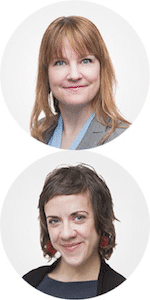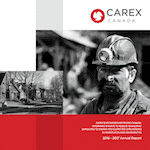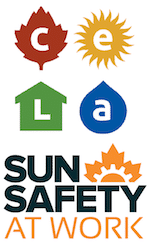IN THIS ISSUE
Spotlight on the CAREX team – Renewal and new roles
Updating resources – Launching eRISK Online tool, offering webinar
Communications Update – Sharing our latest Annual Report
Partner update – New working groups with CELA, Sun Safety at Work
Recent publications – IARC evaluates welding, UV radiation; CELA releases policy tools for radon in daycares

SPOTLIGHT ON THE CAREX TEAM
Renewal and new roles
The CAREX team is pleased to announce that we’ve been refunded by the Canadian Partnership Against Cancer to continue our efforts to develop and mobilize estimates of Canadians exposures to carcinogens in workplace and community environments. Dr. Cheryl Peters is now the Co-Principal Investigator of CAREX Canada, alongside Dr. Anne-Marie Nicol. Cheryl started working with CAREX Canada at the beginning of the project in 2007. She is currently a Postdoctoral Fellow at Carleton University in Ottawa, where she works on projects in environmental and occupational epidemiology and exposure assessment. We are also pleased to announce that Alison Palmer has become CAREX Canada’s Executive Director. Alison was hired on with CAREX Canada five years ago to plan and execute knowledge translation activities, and has since taken on a leadership role. To learn more about CAREX team members, visit our About Us page.

UPDATING RESOURCES
Launching eRISK Online tool, offering webinar
Our newest CAREX Canada tool, eRISK Online, is now available. eRISK Online is an interactive tool developed by CAREX Canada that allows users to explore the cancer risk associated with exposures to known and suspected carcinogens in the environment. There are currently five exposure pathways – outdoor air, indoor air, dust, soil, and drinking water – and over 30 substances – including radon, asbestos, and formaldehyde – to explore. The estimates allow users to compare substances and exposure pathways, and support priority setting for exposure reduction efforts. eRISK Online, along with a Quick Start Guide and a comprehensive User Manual on using the tool, is available here.
On September 21st, 2017 we’re hosting a webinar on how to use the new eRISK Online tool. This webinar will show users how to navigate the tool and interpret the lifetime excess cancer risk results it generates, as well as demonstrate some of the tool’s possible applications. For more information, visit our registration page.

COMMUNICATIONS UPDATE
Sharing our latest Annual Report
This year marks ten years of CAREX Canada. Over this time, our team has worked to establish CAREX Canada as the country’s leading source of evidence on Canadians’ exposures to workplace and environmental carcinogens. In 2016-17, the CAREX team worked with partners across the country at federal, provincial, and municipal levels to mobilize evidence on exposures to workplace and environmental carcinogens in various ways. This work is described in our latest Annual Report, available here. We hope that this report illustrates how our evidence has been applied to prioritize and support efforts to reduce exposures, ultimately helping to reduce the burden of cancer.

PARTNER UPDATE
New working groups with CELA, Sun Safety at Work
This year, we established two new working groups to help put CAREX Canada knowledge into action:
- Canadian Environmental Law Association (CELA): We established a formal working group with CELA to facilitate the exchange of knowledge, expertise, and tools between CELA and CAREX Canada. Our current foci are radon and pesticide exposures. For example, we coordinated our efforts to raise awareness of – and reduce exposure to – radon in schools and daycares.
- Sun Safety at Work Canada (SSAWC): When funding for the SSAWC project expired in September 2016, CAREX Canada took on the coordinating role of its evolution into a national working group. This group brings together 14 organizations to coordinate efforts to reduce workplace sun exposure across Canada. CAREX Canada estimates that approximately 1.5 million Canadians are exposed to solar radiation at work, making it one of our highest priority exposures. The recently launched SSAWC website offers more than 70 free resources on sun safety that are available to download.

RECENT PUBLICATIONS
IARC evaluates welding, UV radiation; CELA releases policy tools for radon in daycares
This month we’re featuring two new publications that appeared in our Carcinogens in the News digest:
- In March 2017, the International Agency for Research on Cancer (IARC) evaluated the carcinogenicity of welding, molybdenum trioxide, and indium tin oxide. Based on the evaluation, molybdenum trioxide and indium tin oxide were both classified as possibly carcinogenic to humans (Group 2B). Welding fumes and ultraviolet (UV) radiation from welding were classified as carcinogenic to humans (Group 1), based on sufficient evidence linking these exposures to lung cancer and ocular melanoma, respectively. Our results show that approximately 87,000 welders are exposed to artificial UV radiation. For more information, visit our artificial UV radiation profile and our summary package on carcinogen exposures in welders.
- Most childcare facilities in Canada are not tested for radon. This radioactive gas can build up in indoor environments, including childcare centres where children and workers may be exposed. To help address this, the Canadian Environmental Law Association and partners compiled a list of four possible policy measures to address radon exposure in childcare settings. This includes childcare licensing rules, building codes, and the rules governing both occupational health and safety and public health. For more information on exposure to radon, visit our radon resources page.
Other stories and reports can be viewed on our Carcinogens in the News page. To sign up for monthly Carcinogens in the News digest, visit our Subscribe page.
Subscribe to our newsletters
The CAREX Canada team offers two regular newsletters: the biannual e-Bulletin summarizing information on upcoming webinars, new publications, and updates to estimates and tools; and the monthly Carcinogens in the News, a digest of media articles, government reports, and academic literature related to the carcinogens we’ve classified as important for surveillance in Canada. Sign up for one or both of these newsletters below.
CAREX Canada
School of Population and Public Health
University of British Columbia
Vancouver Campus
370A - 2206 East Mall
Vancouver, BC V6T 1Z3
CANADA
As a national organization, our work extends across borders into many Indigenous lands throughout Canada. We gratefully acknowledge that our host institution, the University of British Columbia Point Grey campus, is located on the traditional, ancestral, and unceded territories of the xʷməθkʷəy̓əm (Musqueam) people.


